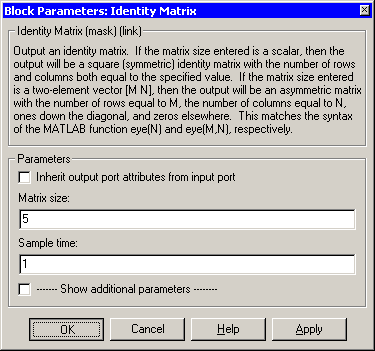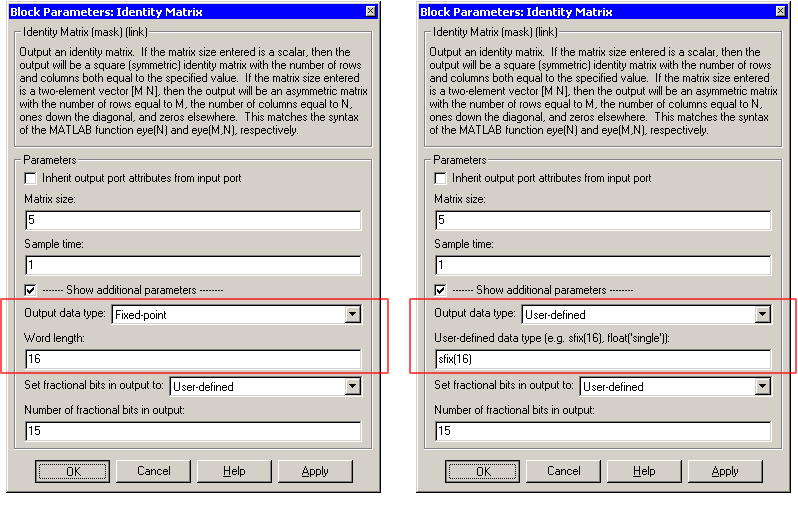| DSP Blockset |
  |
Identity Matrix
Generate a matrix with ones on the main diagonal and zeros elsewhere.
Library
Description

The Identity Matrix block generates a rectangular matrix with ones on the main diagonal and zeros elsewhere.
When the Inherit output port attributes from input port check box is selected, the input port is enabled, and an M-by-N matrix input generates a sample-based M-by-N matrix output with the same sample period. The values in the input matrix are ignored.
When the Inherit output port attributes from input port check box is not selected, the input port is disabled, and the dimensions of the output matrix are determined by the Matrix size parameter. A scalar value, M, specifies an M-by-M identity matrix, while a two-element vector, [M N], specifies an M-by-N unit-diagonal matrix. The output is sample-based, and has the sample period specified by the Sample time parameter.
Example
Set Matrix size to [3 6] to generate the 3-by-6 unit-diagonal matrix below.
Dialog Box

- Inherit output port attributes from input port
- Enables the input port when selected. The output inherits its dimensions and sample period from the input.
- Matrix size
- The number of rows and columns in the output matrix: a scalar
M for a square M-by-M output, or a vector [M N] for an M-by-N output. This parameter is disabled when Inherit input port attributes from input port is selected.
- Sample time
- The discrete sample period of the output. This parameter is disabled when Inherit input port attributes from input port is selected.
- Show additional parameters
- If selected, additional parameters specific to implementation of the block become visible as shown.

- Output data type
- Specify the output data type in one of the following ways:
- Choose one of the built-in data types from the drop-down list.
- Choose Fixed-point to specify the output data type and scaling in the Word length, Set fractional bits in output to, and Number of fractional bits in output parameters.
- Choose User-defined to specify the output data type and scaling in the User-defined data type, Set fractional bits in output to, and Number of fractional bits in output parameters.
- Choose Inherit via back propagation to set the output data type and scaling to match the next block downstream.
- Word length
- Specify the word length, in bits, of the fixed-point output data type. This parameter is only visible if Fixed-point is selected for the Output data type parameter.
- User-defined data type
- Specify any built-in or fixed-point data type. You can specify fixed-point data types using the sfix,
ufix, sint, uint, sfrac, and ufrac functions from the Fixed-Point Blockset. This parameter is only visible if User-defined is selected for the Output data type parameter.
- Set fractional bits in output to
- Specify the scaling of the fixed-point output by either of the following two methods:
- Choose Best precision to have the output scaling automatically set such that the output signal has the best possible precision.
- Choose User-defined to specify the output scaling in the Number of fractional bits in output parameter.
- This parameter is only visible if Fixed-point or User-defined is selected for the Output data type parameter, and if the specified output data type is a fixed-point data type.
- Number of fractional bits in output
- For fixed-point output data types, specify the number of fractional bits, or bits to the right of the binary point. This parameter is only visible if Fixed-point or User-defined is selected for the Output data type parameter, and if User-defined is selected for the Set fractional bits in output to parameter.
Supported Data Types
- Double-precision floating point
- Single-precision floating point
- Fixed-point
- Custom data types
- Boolean
- 8-, 16-, and 32-bit signed integers
- 8-, 16-, and 32-bit unsigned integers
To learn how to convert to the above data types in MATLAB and Simulink, see Supported Data Types and How to Convert to Them.
See Also
Also see the following topics:
 | IDCT | | IDWT |  |







